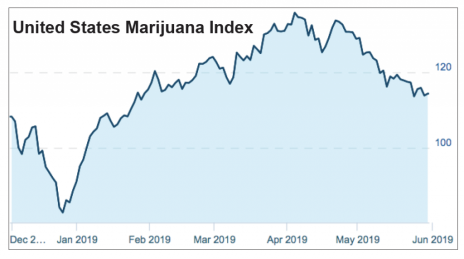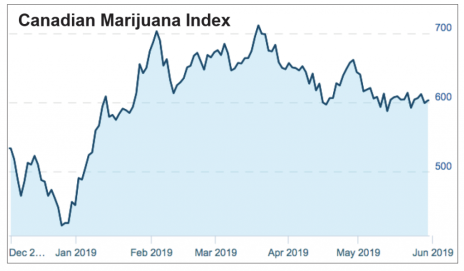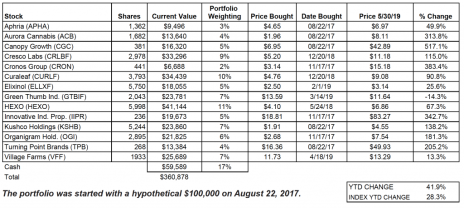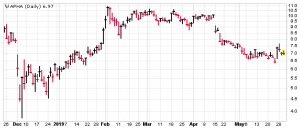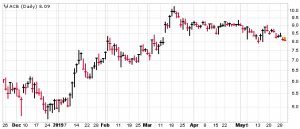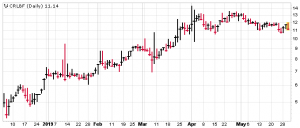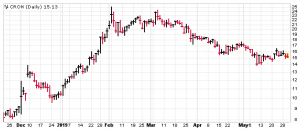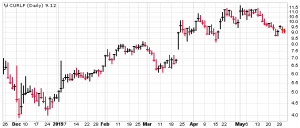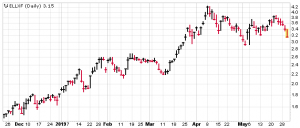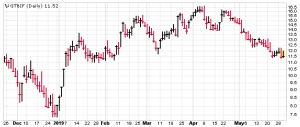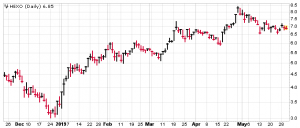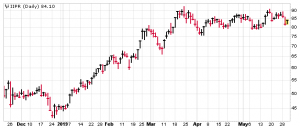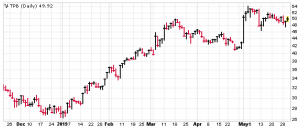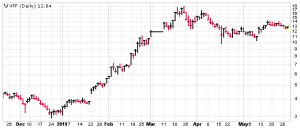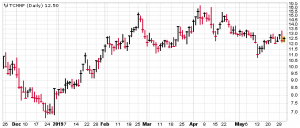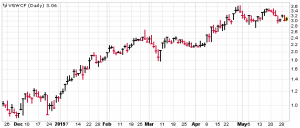The main trend remains up, in both the broad market and the cannabis sector in particular, but in the intermediate-term, we are now in a correction, and thus a little more caution is advised.
In fact, in today’s issue, I’m raising cash by selling portions of the portfolio’s two biggest investments, and then buying some more of one of the portfolio’s “safest” investments, if anything in this industry can be called safe.
Cabot Marijuana Investor 519
Cannabis News
Fundamentally, the fastest-growing industry in America continues its rapid evolution. Some analysts now estimate that marijuana will be an $80 billion business in few years, while CBD sales will hit $16 billion by 2025.
It’s hard to know. But one big step comes tomorrow when the FDA opens a hearing on cannabis. Technically, cannabis covers both marijuana and hemp, but most observers expect the focus of the hearing to be on hemp and CBD, given that the 2018 Farm Bill, which legalized cultivation and production of hemp, has left many observers craving guidance on what would be the appropriate level of CBD in different products.
CVS, as well as numerous smaller retailers, already sell CBD creams, sprays and lotions, but CBD hasn’t yet been approved by the FDA for use in food and drinks.
In announcing the hearings on April 2, FDA Commissioner Scott Gottlieb said that there are “open questions about whether some threshold level of CBD could be allowed in foods without undermining the drug approval process or diminishing commercial incentives for further clinical study of the relevant drug substance.”
Gottlieb is now gone; his replacement, in office since April 5, is Norman Sharpless, previously director of the National Cancer Institute.
Pharmaceutical companies, of course, would like a low CBD limit on consumer products so that higher-potency products can be more profitable.
But before that we need some good hard data on the effectiveness of CBD for the various ailments that it’s been touted as being effective on, so my greatest hope is that the FDA enables an unobstructed path to numerous enlightening studies. Of course, it will take a while.
California Cannabis Banks
A California bill to establish state-chartered cannabis banks is working its way through the state legislature. The bill would allow private banks and credit unions to provide banking services to state-licensed cannabis businesses, including growers and retailers. I assume it will succeed before the Federal government opens the doors to nationwide cannabis banking.
California Marijuana Taxes Double
In the meantime, cannabis tax revenue doubled in California to $116.6 million in the first quarter of 2019, driven by an increased cultivation tax and growth in consumer sales. In addition to the cultivation tax, there’s an excise tax and a sales tax—and not counted in the total were taxes paid to local cities and counties! California is one of the most regulated marijuana business landscapes in the United States, as well as one of the states where the plant is easiest to grow, and as a result, experts estimate that 70 to 80 percent of the marijuana business in the state is still in the gray/black market.
North Dakota
Folks in North Dakota would love the opportunity to buy some of that California marijuana legally, and in one small step to that end, North Dakota has decriminalized marijuana and eliminated jail time for those caught holding small amounts of marijuana for personal use.
A Normal Correction
As to the stocks, we remain in a normal correction in the context of a major bull market. The Cabot Tides, our primary intermediate-term market-timing indicator, remains solidly negative, with all indexes at or near their recent lows. But there is a small sign of hope in the action of the Canadian Marijuana Index.
While the U.S. Marijuana Index continues lower,
The Canadian Index has found repeated support in recent weeks and may have bottomed—though it’s too early to tell.
Investing Strategy
The goal is to keep your eye on the long-term, by holding core positions of the companies most likely to be the industry leaders five and ten years from now, but to be nimble enough with the remainder of your portfolio that you can reduce risk when the environment is difficult—like now. And above all, as in all growth investments, sell losers that are trending down, because you never know how low they’ll go; they often fall farther than you expect.
If you’re just beginning, start slow; build a diversified portfolio over time, starting with some of the stocks I’ve singled out as buys today.
WHAT TO DO NOW
As I write, the portfolio is 17% in cash and I’m going to increase that today via three actions—I’m selling half of our positions in both Cresco Labs (CRLBF) and Curaleaf (CURLF), which up until now have both been overweight; and I’m doubling our position in Turning Point Brands (TPB), making that position slightly overweight. The result of it all is that the portfolio will be about 22% in cash.
CURRENT RECOMMENDATIONS
Aphria (APHA)
Aphria, which had $73.6 million in revenues in the first quarter, is one of the major Canadian marijuana producers, and its stock is one of the cheapest, as measured by price/sales ratio (using 4 times the latest quarter’s revenues). The stock doesn’t currently have positive momentum—but it might soon! Over the past month the stock has been basing in the 7 area, and last Friday, when an analyst at Jeffries initiated coverage with a Buy rating, the stock soared 16% on big volume. But the move didn’t last, and as I write the stock is back in its basing formation. Our portfolio remains underweight the stock, looking to average up once the uptrend resumes. If you don’t own it, you could nibble here. Hold.
Aurora Cannabis (ACB)
Aurora, another Canadian major, had $65 million in revenues in the first quarter. But it’s significantly more expensive than Aphria, and its stock remains in a long correction phase, trading below both its 25- and 50-day moving averages. And if the market worsens, the stock correction has the potential to go to the stock’s 200-day moving average down around 7.5. Nevertheless, long-term prospects are great. The portfolio remains underweight the stock. If you don’t own it, you could nibble here. Hold.
Canopy Growth (CGC)
With a market capitalization of $15.5 billion, Canopy remains the most highly valued of all the cannabis stocks and thus the crowd favorite to be the market leader years from now—at least in Canada. The stock, which is expensive, has been trending sideways since the end of January, and has just pulled back to its 200-day moving average for the second time. If the stock falls through this level, beware; that would be a bad sign for the entire marijuana group. But if it advances from here, new investors can buy.
Cresco Labs (CRLBF)
Chicago-based Cresco is one of the leading vertically integrated multi-state operators in the U.S., with the potential to be one of the U.S. industry leaders in years to come—today, it’s operating in seven states. Yesterday, after the market close, the company reported its first-quarter results. Revenues were $21.1 million, up 313% from the year before. Pro forma revenues, with the pending acquisitions of Origin House and VidaCann, were $33.9 million.
The stock had been consolidating in a range centered on 12 since early April, but it’s been below its 50-day moving average over the past week, and this morning sold off a bit more. The portfolio will sell half now.
Cronos Group (CRON)
Canadian Cronos remains the most overvalued stock in the portfolio (thanks to all the investors who followed Altria on board), but the good news today is that the stock may have bottomed. Three weeks ago it hit 14, close to its 200-day moving average, and since then the buyers have taken it up to 16, and now it’s drifted back down to 15, all with better volume on up days than down days (a good sign). However, the stock is still below its 50-day moving average, which is still trending down, so buying here still seems premature. Remember, the goal is not to pick the bottom; the goal is to avoid buying into a downtrend and instead buy into an uptrend. The portfolio remains underweight the stock, having taken profits earlier, and I expect to average up once this downtrend is definitely past.
Curaleaf Holdings (CURLF)
Massachusetts-based Curaleaf this week announced that it completed the acquisition of the Emerald dispensary in Gilbert, Arizona. The dispensary is expected to be rebranded as Curaleaf over the next month, adding to what the company says is the largest footprint of single-branded retail stores in the U.S.
Curaleaf is now the most highly valued of the U.S. multistate operators, and also the most expensive, on a price/sales basis. Thus, it’s investors’ favorite to be the market leader years from now. But short term, all eyes will be on the company’s first-quarter results, scheduled to be released after the market close today (May 30).
The portfolio has been overweight the stock since March (it simply grew to that state), and has held that overweight position for the past two months as the stock has consolidated its early-2019 gains. But CURLF is now below its uptrending 50-day moving average, so we will sell half to lighten up.
Elixinol (ELLXF)
Colorado-based CBD company Elixinol is the lowest-priced stock in the portfolio and it has the second-lowest market capitalization, so it tends to be more volatile, but it’s got the best chart of the three major CBD stocks (the others are Charlotte’s Web (CWBHF) and Isodiol (ISOLF), which has been showing interesting action lately). The stock is not strong, but it has been tracing out a normal consolidation pattern, and is now just below its 25- and 50-day moving averages. Elixinol has its product in CVS stores in numerous states—where growth could be huge—but in the short term, perhaps the biggest factor will be the FDA’s discussion of CBD, which starts tomorrow.
Green Thumb Industries (GTBIF)
This Chicago-based multi-state operator is the second most valuable of the U.S. players, and the stock is one of our weakest, now heading for support at 11, last touched in January. It’s not a buy here, but still a hold, considering that our loss is tolerable and the company’s fundamentals are strong; latest quarterly revenues were $20.8 million, up 237% from the year before. Hold.
HEXO Corp. (HEXO)
Second-tier Canadian producer HEXO looks darn good—especially considering the weakness of some of its peers—building a base between 6.5 and 7 and supported by its 50-day moving average. HEXO was never as popular as the Canadian majors and thus has seen less selling pressure as the market has weakened. In recent news, HEXO has appointed Michael Monahan, former CFO of Nutrisystem, as its CFO. Monahan will be based in the U.S., where the company is launching HEXO USA. If you don’t own it, you could buy a little here.
Innovative Industrial Properties (IIPR)
Cannabis REIT Innovative Industrial Properties has been a great diversification play for the portfolio, less volatile and surprisingly strong, as it’s found plenty of financing to grow its portfolio of cannabis-business properties—which currently number 21. Technically, the stock is right at its 25- and 50-day moving averages now, while the big picture shows a normal consolidation pattern over the past two months. Last week I wrote, “If it fits in your portfolio, I recommend trying to buy under 80.” We’re getting close.
KushCo Holdings (KSHB)
KushCo is one of the cheapest stocks in the portfolio as measured by price/sales ratio. That’s because it’s not a plant-touching cannabis company, it’s a packaging company, whose products are legal everywhere. It’s also into marketing solutions and industrial bases for processing cannabis. In the latest quarter, revenues were $35.2 million, up 240%.
The stock has been dragged down by the market lately but remains in a long consolidation pattern that began 16 months ago, bounded by 4 on the downside and 8 on the upside. Hold.
Organigram (OGI)
OrganiGram is now trading on the Nasdaq, with a new symbol.
The company is a second-tier player in Canada, but gunning for the first tier; revenues in the first quarter were 33.5 million, up 1,044%. The stock looks like a relative bargain to me, selling at just 9 times revenues. Last but not least, the chart looks great, just six trading days off its record high. Part of this strength, of course, came from the stock’s recent move to the Nasdaq, which attracted a flood of new investors.
Typically stocks tend to cool off for a few months after such an event, but OGI had a good chart before that (it hit a new high on May 1) and it remains in a gentle but definite uptrend.
In recent news, just yesterday, the company announced that it had recently shipped more than 130,000 units of pure cannabidiol (CBD) oil destined for markets across Canada. The hemp came from long-term agreements with 1812 Hemp, a New Brunswick-based industrial hemp research company, and extraction was done by Valens GroWorks (VGWCF), a small company that I’ve now added to my Watch List.
If you don’t own OGI, you could target an entry point at its 50-day moving average, now at 7.1.
Turning Point Brands (TPB)
TPB is the old smokeless tobacco company diversifying very successfully into the cannabis industry—but not plant-touching. The stock blasted out to new highs in early May after releasing an excellent first-quarter report, and has now pulled back to its 25-day moving average in normal action, to what looks like a great entry point. And because the portfolio is now underweight the stock (we took profits earlier), we now have an opportunity to average up.
But I have several reservations. First is the market; the environment is weak, not ideal for new commitments. Second is the company’s growth rate, just 28% in the latest quarter, which is slow for this portfolio; the average company in the portfolio grew 385% in the latest quarter!
On the other hand, the stock is cheap, selling at just three times revenues. And it pays a dividend!
Long term, I don’t see the stock as a portfolio leader (they don’t even sell marijuana), but short term, with defensive stocks acting so well—and easily capable of doing so for longer—my conclusion is that buying more now will probably work out well.
We’ll double our position now, becoming slightly overweight.
Village Farms International (VFF)
Village Farms is somewhat like Turning Point in that it’s fast transitioning from traditional crops (greenhouse tomatoes, peppers and cucumbers) into the cannabis industry—both marijuana (in Canada) and hemp (in Texas).
Village Farms owns and operates greenhouses in Texas that total 5.7 million square feet. One of those, in Monahans, Texas, is named the Permian Basin facility and is one of the most technologically advanced greenhouses in the world, using the company’s proprietary GATES technology, which uses computers to control irrigation, fertilizers, carbon dioxide, light, temperature, ventilation, humidity and other climatic factors, with thousands of different variations.
Last week, the company announced that it had begun conversion of half of this 1.3 million-square foot Permian Basin greenhouse for cultivation of both high-cannabidiol (CBD) hemp and CBD extraction. The tomato crop has already been removed and the construction team is on site, setting up for year-round hemp cultivation. Village Farms expects the facility to be ready for year-round production in the third quarter of 2019, with extraction operations also to be added in the existing facility in 2019.
CEO Michael DeGiglio noted, “Importantly, as a result of its location in West Texas, the Permian Basin facility will not require supplemental lighting for year-round growing, contributing to our overarching objective of low-cost production. It’s a significant advantage over operations in higher latitudes.”
Valuation seems attractive to me, and the stock looks healthy, having bottomed at 11 in April and May and climbed above all its moving averages last week before pulling back normally this week. If you don’t own it, you can buy here.
Stocks to Watch
Trulieve (TCNNF)
Based in Florida, where it operates 26 dispensaries, Trulieve also operates in California, Massachusetts and Connecticut, growing marijuana and selling it in company-owned dispensaries. First-quarter results, announced Tuesday, saw revenue of $44.5 million, up 192% from the year before,
The chart is decent, trending sideways.
Valens GroWorks (VGWCF)
Remember the lesson of the California Gold Rush? The guys who got rich weren’t the miners; they were the guys selling supplies to the miners, like pots and pans and Levi jeans. Valens is a Canadian extraction expert, turning raw plants into crude hemp oil, refined oil, and white label products, so has similar potential for success.
The stock’s chart is healthy, but the company and the stock are rather small. If it were in the portfolio, it would be the smallest of all by market capitalization.
THE NEXT CABOT MARIJUANA INVESTOR WILL BE PUBLISHED June 27, 2019
Neither Cabot Wealth Network nor our employees are compensated by the companies we recommend. Sources of information are believed to be reliable, but are in no way guaranteed to be complete or without error. Recommendations, opinions or suggestions are given with the understanding that subscribers acting on the information assume all risks. © Cabot Wealth Network. Copying and/or electronic transmission of this report is a violation of U.S. copyright law. For the protection of our subscribers, if copyright laws are violated, the subscription will be terminated. To subscribe or for information on our privacy policy, call 978-745-5532, visit www.cabotwealth.com or write to support@cabotwealth.com.


